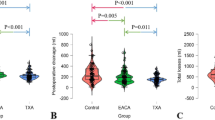Abstract
Patients who undergo major spinal surgery often require multiple blood transfusions. The antifibrinolytics are medications that can reduce blood-transfusion requirements in cardiac surgery and total knee arthroplasty. The present role of synthetic antifibrinolytics, especially tranexamic acid, in reducing peri-operative blood-transfusion requirements in spine surgery is still unclear. The majority of studies exploring the role of these drugs in spine surgery have limited patient enrolment and report mixed results. The goal of the present review is to discuss the pharmacology of tranexamic acid briefly. A brief synopsis of the studies using the synthetic antifibrinolytics for spine surgery is presented. Finally, the potential risks and the benefits of antifibrinolytics are discussed.
Similar content being viewed by others
References
Amar D, Grant FM, Zhang H, Boland PJ, Leung DH, Healey JA (2003) Antifibrinolytic therapy and perioperative blood loss in cancer patients undergoing major orthopedic surgery. Anesthesiology 98:337–342
Benoni G, Lethagen S, Fredin H (1997) The effect of tranexamic acid on local and plasma fibrinolysis during total knee arthroplasty. Thromb Res 85:195–206
Dell R, de Ruiter J, Levine M, Mazzeo F (1999) Does tranexamic acid decrease blood loss in children undergoing posterior spinal fusion for idiopathic scoliosis? Can J Anaesth 46:A56
Fleisher LA (1997) But, is suppression of postoperative ST segment depression an important outcome? Anesth Analg 84:709–711
Florentino-Pineda I, Blakemore LC, Thompson GH, Poe-Kochert C, Adler P, Tripi P (2001) The effect of ±-aminocaproic acid on perioperative blood loss in patients with idiopathic scoliosis undergoing posterior spinal fusion. Spine 26:1147–1151
Fremes SE, Wong BI, Lee E, Mai R, Christakis GT, McLean RF, Goldman BS, Naylor CD (1994) Metaanalysis of prophylactic drug treatment in prevention of postoperative bleeding. Ann Thorac Surg 58:1580–1588
Hardy JF, Desroches J (1992) Natural and synthetic antifibrinolytics in cardiac surgery. Can J Anaesth 39:353–365
Hiippala ST, Strid LJ, Wennerstrand MI, Arvela JV, Niemela HM, Mantyla SK, Kuisma RP, Ylinen JE (1997) Tranexamic acid radically decreases blood loss and transfusions associated with total knee arthroplasty. Anesth Analg 84:839–844
Ho KM, Ismail H (2003) Use of intravenous tranexamic acid to reduce allogeneic blood transfusion in total hip and knee arthroplasty: a meta-analysis. Anaesth Intens Care 31:529-537
Horrow JC, Van Riper DF, Strong MD, Grunewald KE, Parmet JL (1995) The dose response relationship of tranexamic acid. Anesthesiology 82:383–392
Hynes M, Calder P, Scott G (2003) The use of tranexamic acid to reduce blood loss during total knee arthroplasty. Knee 10:375-377
Klein HG (1999) Immunomodulatory aspects of transfusions. A once and future risk? Anesthesiology 91:861–865
Klenerman L, Mackie I, Chakrabarti R, Brozovic M, Stirling Y (1977) Changes in haemostatic system after application of a tourniquet. Lancet I:970–972
Laupacis A, Fergusson D (1997) Drugs to minimize perioperative blood loss in cardiac surgery: meta-analysis using perioperative blood transfusion as the outcome. Anesth Analg 8:1258–1267
Lin R, Baker A, Rose K, Garvey B, McBroom R (1996) Bleeding and coagulopathy associated with major spinal surgery [abstract]. Can J Anaesth 43:A46
Murray DJ, Pennell BJ, Weinstein SL, Olson JD (1995) Packed red cells in acute blood loss: dilutional coagulopathy as a cause of surgical bleeding. Anesth Analg 80:336–342
Neilipovitz DT, Murto K, Hall L, Barrowman NJ, Splinter WM (2001) A randomized trial of tranexamic acid to reduce blood transfusion for scoliosis surgery. Anesth Analg 93:82–87
Orth VH, Rehm M, Thiel M, Kreimeier U, Haller M, Brechtelsbauer H, Finsterer U (1998) First clinical implications of perioperative red cell volume measurement with a nonradioactive marker (sodium fluorescein). Anesth Analg 87:1234–1238
Petäjä J, Myllynen P, Myllylä G, Vahtera E (1987) Fibrinolysis after application of a pneumatic tourniquet. Acta Chir Scand 153:647–651
Rhine EJ, Ménard EA (1991) Anesthetic considerations for spinal instrumentation in pediatric patients. Probl Anesth 5:67–79
Sackett DL (1981) How to read clinical journals. V. To distinguish useful from useless or even harmful therapy. Can Med Assoc J 124:1156–1162
Thomas MJG, Gillon J, Desmond MJ (1996) Preoperative autologous donation. Consensus conference on autologous transfusion. Transfusion 36:633–639
Tretiak R, Laupacis A, Rivière M, McKerracher K, Souetre E (1996) Cost of allogeneic and autologous blood transfusion in Canada. Canadian Cost of Transfusion Study Group. Can Med Assoc J 154:1501–1508
Urban MK, Beckman J, Gordon M, Urquhart B, Boachie-Adjei O (2001) The efficacy of antifibrinolytics in the reduction of blood loss during complex adult reconstructive spine surgery. Spine 26:1152–1157
Veien M, Sorensen JV, Madsen F, Juelsgaard P (2002) Tranexamic acid given intraoperatively reduces blood loss after total knee replacement: a randomized, controlled study. Acta Anaesthesiol Scand 46:1206-1211
Zheng F, Cammisa FP, Jr Sandhu HS, Girardi FP, Khan SN (2002) Factors predicting hospital stay, operative time, blood loss, and transfusion in patients undergoing revision posterior lumbar spine decompression, fusion, and segmental instrumentation. Spine 27:818–824
Author information
Authors and Affiliations
Corresponding author
Rights and permissions
About this article
Cite this article
Neilipovitz, D.T. Tranexamic acid for major spinal surgery. Eur Spine J 13 (Suppl 1), S62–S65 (2004). https://doi.org/10.1007/s00586-004-0716-2
Received:
Accepted:
Published:
Issue Date:
DOI: https://doi.org/10.1007/s00586-004-0716-2




